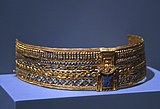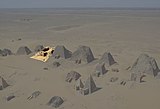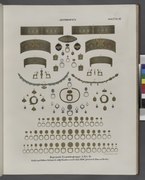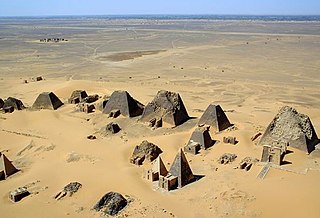
The Nubian pyramids were built by the rulers of the ancient Kushite kingdoms. The area of the Nile valley known as Nubia, which lies in northern present-day Sudan, was the site of three Kushite kingdoms during antiquity. The capital of the first was at Kerma. The second was centered on Napata. The third kingdom was centered on Meroë. The pyramids are built of granite and sandstone.

Jebel Barkal or Gebel Barkal is a mesa or large rock outcrop located 400 km north of Khartoum, next to Karima in Northern State in Sudan, on the Nile River, in the region that is sometimes called Nubia. The jebel is 104 m tall, has a flat top, and came to have religious significance for both ancient Kush and ancient Egyptian occupiers. In 2003, the mountain, together with the extensive archaeological site at its base, were named as the center of a World Heritage Site by UNESCO. The Jebel Barkal area houses the Jebel Barkal Museum.

Apedemak or Apademak was the Chief deity in the ancient Kushite pantheon. Often depicted as a figure with a male human torso and a lion head, Apedemak was a war god worshiped by the Meroitic peoples inhabiting Kush. He has no Egyptian counterpart. As a war god, Apedemak came to symbolize martial power, military conquest, and empire for the Meroitic peoples. Apedemak is also closely associated with Amun, the state-sponsored Egyptian deity during the preceding Napatan period, and is assumed to hold an equal level of importance.
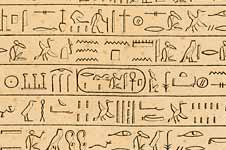
Alara was a King of Kush, who is generally regarded as the founder of the Napatan royal dynasty by his 25th Dynasty Kushite successors and was the first recorded prince of Kush. He unified all of Upper Nubia from Meroë to the Third Cataract and is possibly attested at the Temple of Amun at Kawa. Alara also established Napata as the religious capital of Kush. Alara himself was not a 25th dynasty Kushite king since he never controlled any region of Egypt during his reign compared to his two immediate successors: Kashta and Piye respectively. Nubian literature credits him with a substantial reign since future Nubian kings requested that they might enjoy a reign as long as Alara's. His memory was also central to the origin myth of the Kushite kingdom, which was embellished with new elements over time. Alara was a deeply revered figure in Nubian culture and the first Kushite king whose name came down to scholars.
Shorkaror was a king of Kush who ruled from Meroë in the second half of the 1st century AD. Shorkaror is attested as king in two inscriptions in Amara and in a large rock carving at Gebel Qeili. His identification as a king has sometimes been doubted, though the rock carving depicts him with royal regalia and attire. The carving is near to the trade route to Kassala and is the easternmost inscription of the Meroitic kings found so far.

Shanakdakhete, also spelled Shanakdakheto or Sanakadakhete, was a queen regnant of the Kingdom of Kush, ruling from Meroë in the early first century AD. Shanakdakhete is poorly attested, though is known to have constructed a temple in Naqa.

Amanikhareqerem was a King of Kush who ruled during the late 1st century AD. In older research he was placed into the 2nd century AD. or possibly earlier. His chronological position means that he may have succeeded Shorkaror and preceded Amanitenmemide. It is impossible to securely identify where Amanikhareqerem was buried. It has been suggested that he was buried in the pyramid Beg. N 16 in Meroë.
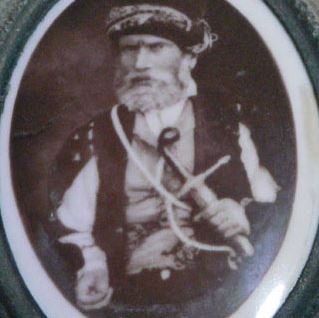
Giuseppe Ferlini was an Italian soldier turned treasure hunter, who robbed and desecrated the pyramids of Meroë.

Kandake, kadake or kentake, often Latinised as Candace, was the Meroitic term for the sister of the king of Kush who, due to the matrilineal succession, would bear the next heir, making her a queen mother. She had her own court, probably acted as a landholder and held a prominent secular role as regent. Contemporary Greek and Roman sources treated it, incorrectly, as a name. The name Candace is derived from the way the word is used in the New Testament.
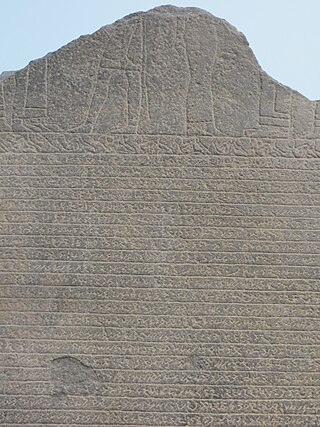
Amanirenas, was queen regnant of the Kingdom of Kush from the end of the 1st century BCE to beginning of the 1st century CE. She is known for halting the Roman expansion into Kush in present-day Sudan.

Senkamanisken was a Kushite King who ruled from 640 to 620 BC at Napata. He used royal titles based on those of the ancient Egyptian pharaohs.

Aryamani was a Nubian king.

Amanitore, also spelled Amanitere or Amanitare, was a queen regnant of the Kingdom of Kush, ruling from Meroë in the middle of the 1st century CE. She ruled together with her son, Natakamani. The co-reign of Amanitore and Natakamani is a very well attested period and appears to have been a prosperous time. They may have been contemporaries of the Roman emperor Nero.

The Kingdom of Kush, also known as the Kushite Empire, or simply Kush, was an ancient kingdom in Nubia, centered along the Nile Valley in what is now northern Sudan and southern Egypt.
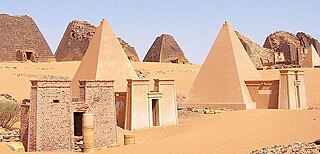
The Pyramids of Meroë are a large number of Nubian pyramids, encompassing three cemeteries near the ancient city of Meroë. The Meroë pyramids date to the later stage of the Kingdom of Kush and were burial places for Kushite monarchs, other members of the royal family, and important officials and dignitaries.

Nawidemak was a queen regnant of Kush who probably ruled in the first half of the 1st century AD. She is known from the wall relief of her burial chamber, as well as a gold plaque.

Amanipilade is the name conventionally attributed to a Kushite queen regnant buried in pyramid Beg N. 25 in Meroë. Amanipilade ruled the Kingdom of Kush from Meroë in the middle of the fourth century AD. Circumstantial and indirect evidence suggests that she might have been the last ruler of the kingdom.

Nubia is a region along the Nile river encompassing the area between the first cataract of the Nile as well as the confluence of the blue and white Niles or, more strictly, Al Dabbah. Nubia was the seat of several civilizations of ancient Africa, including the Kerma culture, the kingdom of Kush, Nobatia, Makuria and Alodia.
Shesepankhenamen Setepenre is the Horus name of an otherwise unknown king of Kush, ruling from Meroë in the second half of the 3rd century BCE. His personal name is unknown. The Horus name is known only from fragmentary inscriptions on a stray block in Meroë's northern cemetery. No burial site has been identified for this king.




